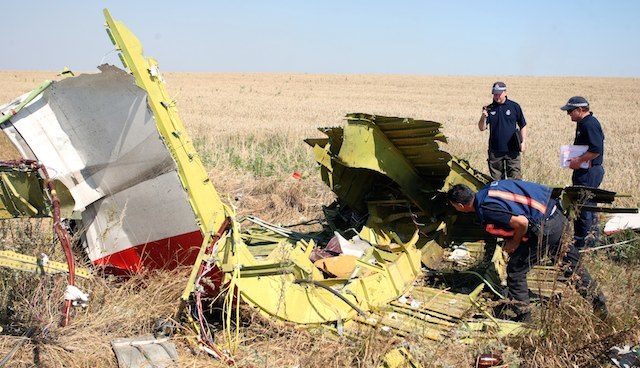SUMMARY
This is AI generated summarization, which may have errors. For context, always refer to the full article.

GILZE-RIJEN, Netherlands (2nd UPDATE) – Air crash investigators concluded Tuesday, October 13, that Malaysia Airlines flight MH17 was shot down by a Russian-made BUK missile fired from war-torn eastern Ukraine last year killing all 298 people on board.
Even though the Dutch-led inquiry did not say who pulled the trigger, Russian officials were already disputing the findings set to further degrade strained ties between Moscow and the West.
“Flight MH17 crashed as a result of the detonation of a warhead outside the airplane against the left-hand side of the cockpit,” the chairman of the Dutch Safety Board, Tjibbe Joustra, told a press conference.
“This warhead fits the kind of missile that is installed in the BUK surface-to-air missile system.”
The much-anticipated report also said it was possible that some on board the Boeing 777 en route from Amsterdam to Kuala Lumpur may have been conscious during the 90 seconds it took to crash on July 17 last year.
Malaysia vowed it would seek the prosecution of the “trigger happy criminals” who downed the flight, the second aviation tragedy for the country after the mysterious disappearance of flight MH370 in March 2014.
“The wreckage was spread over several sites” near the villages of Grabove, Rozsypne and Ptropavlivka, most of which were in rebel territory, the Dutch report said.
The inquiry has marked out a 320-square-kilometer (120 square mile) area in eastern Ukraine from which the missile must have been fired to cause the amount of damage.
But it did not specify whether it came from an area under the control of pro-Russian separatists battling Ukrainian forces.
Eerie reconstruction
Standing in front of an eerie reconstruction of the plane’s cockpit made from the wreckage, Joustra said the inquiry had not pinned down the exact location of the missile launch site, saying that would take further investigation.
But earlier the respected Volkskrant daily said sources close to the investigation had pointed to it being fired by pro-Russian rebels.
“The BUK missile is developed and made in Russia,” one source told the daily.
“It can be assumed that the rebels would not be able to operate such a device. I suspect the involvement of former Russian military officials.”
Joustra also hit out at the Ukrainian authorities for allowing civil aircraft to continue to fly above the eastern part of the country despite the raging conflict between Kiev’s forces and pro-Russian separatist insurgents.
160 planes in the sky
On the day that MH17 was blown out of the skies, some 160 commercial flights overflew the area, the inquiry said.
“There was sufficient reason for the Ukrainian authorities to close the air space above the eastern part of their country,” Joustra said.
Relatives earlier emerged visibly shaken after being privately briefed by Joustra in an conference center. One of them, Robby Oehlers said a wave of sadness had swept through the room.
“They showed us the fragments that were inside the plane,” Oehlers said, adding in the room “it was so quiet, you could have heard a pin drop.”
The downing of MH17 threw the global spotlight back on the uprising in eastern Ukraine and was followed by a toughening of Western sanctions against Russia.
Tuesday’s findings were swiftly dismissed by the missile maker Almaz-Antey, after a test which “disputes the version of the Dutch,” adding the damage to the MH17 pointed to the use of an older type of missile.
“The results of the experiment completely dispute the conclusions of the Dutch commission about the type of the rocket and the launch site,” said Yan Novikov, director of Almaz-Antey.
‘Planned operation’
Ukrainian Prime Minister Arseniy Yatsenyuk meanwhile blamed Russia’s security service.
“I personally have no doubt that this was a planned operation of the Russian special services aimed at downing a civilian aircraft,” Yatsenyuk told a cabinet meeting.
The Dutch report makes 11 recommendations, aiming to improve safety for civilian aircraft.
They include that countries involved in a conflict should close their air space in a timely manner, and that stricter rules should be applied by international aviation bodies.
But it has stressed its mandate was not to determine who pulled the trigger, amid a separate criminal probe by Dutch prosecutors.
Dutch Prime Minister Mark Rutte called on Russia to cooperate in the criminal investigation, adding “the priority now is to find and pursue those who are responsible.”
Oehlers said relatives had been told “there was a zero percent chance that the people inside felt anything or had any notion of what was happening.”
But the report states “it cannot be ruled out that some occupants remained conscious for some time during the one to one-and-a-half minutes for which the crash lasted.” – Maude Brulard and Jan Hennop, AFP / Rappler.com
Add a comment
How does this make you feel?
There are no comments yet. Add your comment to start the conversation.